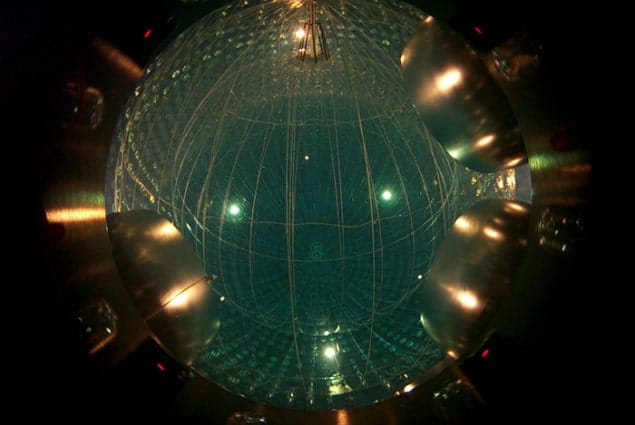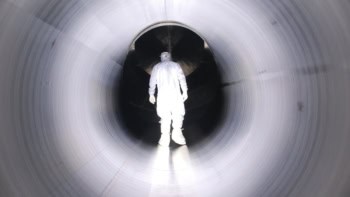
The best measurement yet of the lifetime of the electron suggests that a particle present today will probably still be around in 66,000 yottayears (6.6 × 1028 yr), which is about five-quintillion times the current age of the universe. That is the conclusion of physicists working on the Borexino experiment in Italy, who have been searching for evidence that the electron decays to a photon and a neutrino; a process that would violate the conservation of electrical charge and point towards undiscovered physics beyond the Standard Model.
The electron is the least-massive carrier of negative electrical charge known to physicists. If it were to decay, energy conservation means that the process would involve the production of lower-mass particles such as neutrinos. But all particles with masses lower than the electron have no electrical charge, and therefore the electron’s charge must “vanish” during any hypothetical decay process. This violates “charge conservation”, which is a principle that is part of the Standard Model of particle physics. As a result, the electron is considered a fundamental particle that will never decay. However, the Standard Model does not adequately explain all aspects of physics, and therefore the discovery of electron decay could help physicists to develop a new and improved model of nature.
This latest search for electron decay was made using the Borexino detector, which is designed primarily to study neutrinos. It is located deep under a mountain at the Gran Sasso National Laboratory to shield it from cosmic rays and comprises 300 tonnes of an organic liquid that is viewed by 2212 photomultipliers.
Photon hunting
The Borexino team focused on a specific hypothetical decay process in which an electron in the organic liquid decays to an electron neutrino and a photon with energy 256 keV. This photon then goes on to interact with electrons in the liquid to produce a distinct flash of light that is detected by the photomultipliers.
The physicists sifted through all of the photomultiplier signals recorded from January 2012 to May 2013, looking for signatures of a 256 keV photon. To do so, they first had to subtract the signals from a number of unrelated processes that occur in the detector and produce similar amounts of light as a 256 keV photon. These include the radioactive decays of several trace isotopes in the detector, as well as light from the neutrino collisions that Borexino is designed to detect. After taking these background signals into consideration, the team was able to say that no electron decays were observed during the 408-day run.
Borexino’s organic liquid contains a vast number of electrons (about 1032), and the fact that no electron decays were seen during the search allowed the team to estimate a minimum value for the average lifetime of the electron. The researchers’ minimum lifetime of 6.6 × 1028 yr is more than 100 times greater than the previous lower limit of 4.6 ×1026 yr. This was measured back in 1998 by the Borexino Counting Test Facility, which was a precursor to the current experiment.
Invisible channels
Gianpaolo Bellini, who is spokesperson for Borexino, told physicsworld.com that if the detector could be further purified to virtually eliminate all background radiation, the minimum lifetime measurement could be boosted to greater than 1031 yr. He points out that Borexino could also be used to search for decays into the “invisible channel” whereby an electron is converted into three neutrinos, or could even look for the “disappearance” of an electron into extra dimensions.
Victor Flambaum of the University of New South Wales in Australia told physicsworld.com that searches for the violation of apparent symmetries are very important because even a small violation can have profound implications on our understanding of the universe. Flambaum, who is not a member of the Borexino team, points out that the experimental discovery that charge–parity (CP) symmetry is violated was made by observing the decays of kaons. CP violation plays an important role in our current understanding of why there is much more matter than antimatter in the universe.
The search is described in Physical Review Letters.



